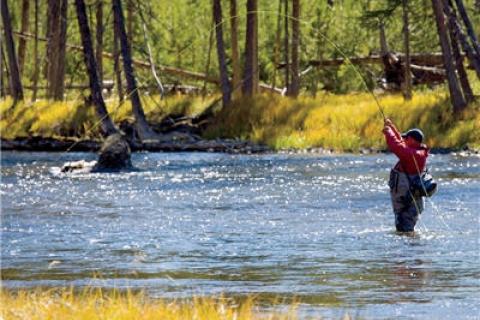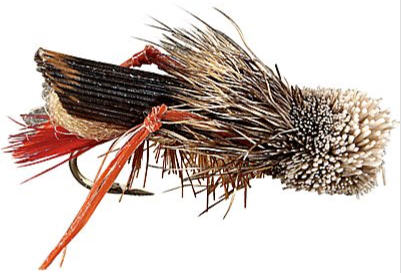
Trout fishermen traditionally cast imitations of aquatic insects such as mayflies and caddis. But some of the best fall fly-fishing comes from imitating "terrestrial" insects. These are bugs that are born and live on land, but accidentally jump, fall, get blown by wind, or washed into streams by rain. When they meet that unfortunate fate, their bad luck is compounded: they are almost immediately gobbled up by waiting brook, brown, cutthroat, and rainbow trout.
Best Land Insects to Imitate
 |
| White River Fly Shop 30-Piece Hopper Dropper Fly Assortment |
A number of land-born insects are important in the diet of trout. Ants, beetles, crickets, leafhoppers, caterpillars and cicadas are a few of them. But the one that offers the most spectacular sport of all now is the grasshopper. Fishing imitations of these insects is particularly exciting because it draws strikes from some of the largest trout in a stream.
![]() Extra Tip: Hoppers come in a wide variety of sizes and colors. Try to match the size of the insects that jump up along shore as you walk along the stream. Patterns from size 2 to 14 can be effective. Most common colors are tan, yellow, green and brown.
Extra Tip: Hoppers come in a wide variety of sizes and colors. Try to match the size of the insects that jump up along shore as you walk along the stream. Patterns from size 2 to 14 can be effective. Most common colors are tan, yellow, green and brown.
![]() Extra Tip: Besides matching the size of insects you see, it’s generally best to use smaller flies on smaller streams and larger ones on big rivers. Small stream fish tend to be more skittish, and those in big waters may need a chunkier morsel to draw their attention.
Extra Tip: Besides matching the size of insects you see, it’s generally best to use smaller flies on smaller streams and larger ones on big rivers. Small stream fish tend to be more skittish, and those in big waters may need a chunkier morsel to draw their attention.
Best Seasons, Time of Day & Weather to Fish With Grasshopper Flies
Grasshoppers actually start appearing along stream borders in May. It’s during late summer and fall, though, particularly September and October, that they reach peak numbers and trout key in on them for the most frenzied feeding binges. In the southern part of the country, you can occasionally find a few grasshoppers active into early November during mild years.
Fishing with hoppers is most productive from mid-morning until late afternoon. That’s when it’s hottest and that’s when the insects are most active and most likely to fall or accidentally jump into a stream. Top weather conditions are warm, sunny, and dry. On rainy, cool days, opt for other flies.
![]() Extra Tip: Wind is also a plus for grasshopper fishing, since it blows the land insects into the water more frequently.
Extra Tip: Wind is also a plus for grasshopper fishing, since it blows the land insects into the water more frequently.
Deliveries & Fly Casting Tactics
Grasshoppers make a distinct “splat” when they enter a river. Trout learn to key in on this sound and race towards it when they hear a hopper tumble into the water. By dropping your fly with a “plop” you can duplicate this sound and draw strikes.
Simply overpower your forward cast slightly to smack the fly onto the water. This sound of an insect hitting the water is like ringing a dinner bell for any hungry trout lying nearby.
![]() Extra Tip: Another good delivery for grasshopper patterns is the sidearm skip cast, which skitters the fly over the water and allows you to bounce the hopper back under shoreline brush, where big fish often lurk.
Extra Tip: Another good delivery for grasshopper patterns is the sidearm skip cast, which skitters the fly over the water and allows you to bounce the hopper back under shoreline brush, where big fish often lurk.
 |
| When the wind starts to gust, it’s time to work the water with a Clipped Head Hopper. |
Where to Cast Your Fly
The biggest trout often hang out within inches of the stream banks when hoppers are falling in, waiting for them. Dropping your fly very close to the water’s edge is a good tactic, since that’s where the fish are used to seeing the insects tumble in from. The “dap” cast—simply reaching your rod out with a length of leader extended and dropping the fly above the fish—is often deadly for these shore-hugging trout.
![]() Extra Tip: The shore where the wind is blowing from is often best. But don’t ignore mid-stream locations, either. Once hoppers get in the water, currents can carry them far from land.
Extra Tip: The shore where the wind is blowing from is often best. But don’t ignore mid-stream locations, either. Once hoppers get in the water, currents can carry them far from land.
![]() Extra Tip: Grasshoppers kick their legs and try to escape when they fall in a stream. Imitate this with a twitch of your rod tip when the fly drifts over a fish or suspected holding lie. Just nudge it slightly so it barely quivers.
Extra Tip: Grasshoppers kick their legs and try to escape when they fall in a stream. Imitate this with a twitch of your rod tip when the fly drifts over a fish or suspected holding lie. Just nudge it slightly so it barely quivers.
 |
| Montana Fly Company Elk Hair Caddis FliesMontana Fly Company Elk Hair Caddis Flies |
Hopper Tackle: These bulky flies work best with a fly rod that has some backbone. Use an 8 ½-9 ½ foot 5-7 weight fly rod with a weight-forward floating line. An 8-12 foot leader tapering to a 3-6X tippet completes the setup.
Patterns:A variety of patterns work well. Some of the best include the Joe’s Hopper, Dave’s Hopper, Montana Fly Company Clipped Head Hopper, Letort Hopper, Foam Hopper, and Nymph Hopper. If you run out of grasshopper imitations, an Elk Hair Caddis makes a good fill-in fly.
Bonus: Bass and Panfish: Grasshoppers are large enough that they can produce excellent catches of bass and panfish on ponds and creeks.
Fish grasshopper flies on ponds for largemouths and bluegills and on creeks and rivers for smallmouths and spotted bass.
![]() Extra Tip: For bass use sizes 2-8 grasshopper flies. For panfish with their smaller mouths, go with sizes 10-14.
Extra Tip: For bass use sizes 2-8 grasshopper flies. For panfish with their smaller mouths, go with sizes 10-14.
- 7567 views

